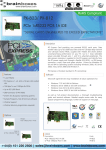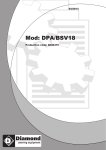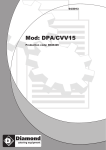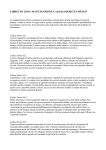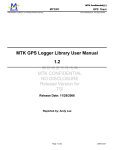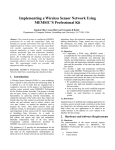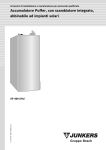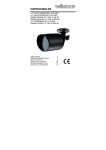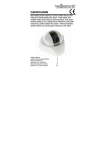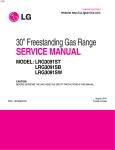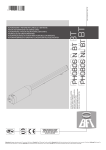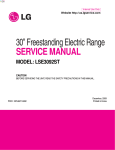Download Mod: DPA/PVV12
Transcript
04/2013 Mod: DPA/PVV12 Production code: 8046429 “SELF IN” I GB DE FR MANUALE D’INSTALLAZIONE, USO E MANUT ENZIONE PER ELEMENTI CON PIANO RISCALDANTE IN CRISTALLO TEMPERATO AD INCASSO INSTALLATION, OPERAT ING AND MAINTENANCE MANUAL FOR UNITS WITH SAFETY GLASS COOKT OP TO BE BUILT IN INSTALLATIONS-, BEDIENUNGS- UND WART UNGSANLEITUNG FÜR ELEMENTE MIT BEHEIZTER PLATTE AUS GEHÄRT ETEM KRISTALLGLAS ZU EINBAUEN NOTICE D’INSTALLATION, UTILISATION ET ENTRETIEN POUR ELEMENTS AVEC PLAN CHAUFFANT EN VERRE T REMPE A ENCASTRER A010323 Rev. 1 Pag. 1 di 8 I MANUALE D’INSTALLAZIONE, USO E MANUT ENZIONE PER ELEMENTI CON PIANO RISCALDANTE IN CRISTALLO TEMPERATO “SELF IN” 1. AVVERTENZE Leggere con attenzione il presente Manuale prima di procedere all’installazione. Il Manuale è concepito per dare all’utilizzatore le informazioni necessarie all’impiego dell’apparecchiatura in condizioni di sicurezza, dal trasporto al momento dello smantellamento. Il manuale deve essere conservato con cura, per essere disponibile in caso di future consultazioni. In caso di cessione dell’apparecchiatura, il manuale deve essere consegnato al nuovo utente. ATTENZIONE: SE LA SUPERFICIE DEL PIANO IN CRISTALLO TEMPERATO PRESENTA DELLE FESSURE SCOLLEGARE IMMEDIATAMENTE L’APPARECCHIO DALLA RETE ELETTRICA. Per un corretto utilizzo dell’apparecchiatura: · Non manomettere i dispositivi di sicurezza; · Utilizzare solo per gli scopi specificatamente previsti; · Evitare la presenza di personale estraneo in prossimità dell’apparecchiatura; · Impiegare per la manutenzione esclusivamente personale qualificato; · Disattivare l’apparecchiatura in caso di guasto o di funzionamento irregolare; · Utilizzare esclusivamente ricambi forniti dal Costruttore o da questi indicati. · Fogli di alluminio e recipienti in materiale plastico non devono essere posti sulle superfici calde. · Evitare di colpire energicamente il piano in cristallo temperato. ATTENZIONE: L’ACCESSO AL QUADRO ELETTRICO PRINCIPALE E A TUTTE LE ALTRE PARTI ELETTRICHE, SIA PER L’INSTALLAZIONE CHE PER LA MANUTENZIONE, È AUTORIZZATO SOLO A PERSONALE QUALIFICATO. Il Costruttore declina ogni responsabilità per i danni a cose o persone causati dalla mancata osservanza delle istruzioni e precauzioni contenute nel manuale. Per qualsiasi dubbio o necessità rivolgersi al RIVENDIT ORE. 2. INTRODUZIONE L’apparecchiatura è conforme alle Direttive 2004/108 CEE e 2006/95 CEE. Sono state inoltre applicate le norme EN 60335-1, EN 60335-2-36, EN 60335-2-48, EN 55014, EN 61000-3-2 ed EN 61000-3-3. 3. DESCRIZIONE DELLE APPARECCHIATURE I nostri ELEMENTI CON PIANO RISCALDANT E IN CRIST ALLO TEMPERAT O sono costituiti da un piano in cristallo temperato. La temperatura massima di funzionamento e di circa 120°C. 4. TRASPORTO E MOVIMENTAZIONE Se l’apparecchiatura viene trasportata su pallet deve essere scaricata mediante carrello elevatore o altro macchinario di sollevamento idoneo, manovrati da personale addestrato. Il peso massimo è indicato in Tabella A. Eventuali errori di manovra potrebbero causare infortuni per schiacciamento. Qualora le superfici dell’apparecchiatura subissero urti esse sarebbero immediatamente rovinate. In questa fase deve essere vietata la sosta nelle immediate vicinanze a chiunque non sia coinvolto direttamente nell’operazione. Il personale che effettua la movimentazione deve essere munito di mezzi di protezione personale adeguati (ad es.: guanti da lavoro, scarpe antinfortunistiche). 5. CONDIZIONI DI UTILIZZO E CARATTERISTICHE TECNICHE I nostri ELEMENTI CON PIANO RISCALDANT E IN CRISTALLO TEMPERAT O sono concepiti unicamente per l’esposizione e il mantenimento in temperatura di alimenti posti in teglie e tegami, in locali adibiti alla ristorazione collettiva. Ogni altro impiego è da ritenersi improprio. La temperatura max di funzionamento del piano riscaldante è di 120°C. Gli ELEMENTI CON PIANO RISCALDANT E IN CRISTALLO TEMPERAT O sono disponibili secondo le configurazioni riportate nella Tabella A. 5.1 Comandi e controlli I dispositivi di comando sono raggruppati sul cruscotto descritto in Fig. 1. I componenti elettrici sono a norma. 5.2 Protezioni e dispositivi di sicurezza · · · Dispositivi di sicurezza: Termostato di sicurezza a riarmo automatico per ogni singola resistenza. Dispositivi di protezione individuale: Si consiglia l’uso di presine o guanti a causa della temperatura raggiungibile dai contenitori delle vivande o stoviglie riscaldate. Disposizioni particolari a copertura di rischio residuo: Limitare l’accesso alle sole persone addette, che devono essere informate sui pericoli potenziali dovuti alla temperatura. A010323 Rev. 1 Pag. 2 di 8 6. INSTALLAZIONE I 6.1 Operazioni preliminari L’utilizzatore deve predisporre l’alimentazione elettrica secondo quanto riportato in Fig. 3 (nel caso di montaggio fisso), nel rispetto delle norme vigenti. 6.2 Posizionamento Posizionare l’apparecchiatura con l’eventuale aiuto di un transpallet. Se questo spostamento avviene dopo il disimballo, proteggere le superfici dagli urti. Una volta completata l’installazione è possibile togliere la pellicola protettiva. L’operazione va fatta molto lentamente per evitare che la colla rimanga sulle superfici. Qualora ciò avvenga, passare con kerosene o benzina. 6.3 Collegamenti elettrici Devono essere effettuati da personale qualificato nel rispetto delle norme locali vigenti. Il circuito elettrico dell’apparecchiatura è progettato per funzionare con una tensione di alimentazione a 230 Volt monofase e frequenza 50/60 Hz. Vedere schema elettrico Fig. 2 riferito al modello acquistato. Il collegamento elettrico avviene collegando un cavo alla morsettiera dell’apparecchiatura. Il cavo deve avere delle caratteristiche minime del tipo H05 RNF ed un conduttore di terra efficiente e correttamente dimensionato in base alla potenza totale di questo apparecchio e degli eventuali altri apparecchi o accessori collegati sulla stessa morsettiera (vedi targhetta) L’impianto elettrico di alimentazione dell’apparecchio deve essere dotato, a monte, di un interruttore automatico onnipolare correttamente dimensionato che garantisca un’apertura fra i contatti di almeno 3 mm. Il cavo di terra non deve essere interrotto. La sicurezza elettrica di questa apparecchiatura è assicurata unicamente quando sono soddisfatte le condizioni predette e se il sistema è in regola anche sotto il profilo dell’equipotenzialità (utilizzare la vite di collegamento posta in prossimità dell’entrata del cavo di alimentazione e dell’adesivo con simbolo) Il costruttore declina ogni responsabilità in caso di mancato r ispetto di queste norme antinfortunistiche. 7. FUNZIONAMENTO / USO 7.1 Consigli per l’uso · · · · Questa apparecchiatura dovrà essere destinata solo all’uso per la quale è stata espressamente concepita: cioè per l’esposizione e il mantenimento di alimenti in temperatura posti in teglie e tegami. Ogni altro impiego è da ritenersi improprio. Per evitare graffi sul piano in cristallo temperato si consiglia l’uso di teglie e tegami con fondo liscio e piano. Se si utilizza il piano in cristallo temperato (a freddo) come piano di lavoro, è necessario pulirlo perfettamente prima di accenderlo. Appoggiando pentole su residui abrasivi, il piano in cristallo temperato potrebbe graffiarsi. Prima di utilizzare l’apparecchiatura per la prima volta, pulire il piano in cristallo temperato con un prodotto adatto e carta assorbente da cucina. Evitare l’uso di detersivi o polveri abrasive. Quindi ripassare con un panno umido ed asciugare accuratamente. 7.2 Messa in funzione · Per dare tensione al piano in cristallo mettere l’interruttore A in pos. 1 (Fig.1) , regolare il termostato B alla temperatura desiderata, quando la piastra è in funzione si accende la spia C . La scala graduata è solamente indicativa. 7.3 Spegnimento Spegnere l’apparecchiatura ruotando la manopola di Fig. 1 in senso antiorario fino a fine corsa, mettere l’interruttore A in pos. 0. Disinserire l’interruttore a monte dell’apparecchiatura. In caso di spegnimento prolungato: a) escludere l’alimentazione elettrica; b) pulire accuratamente il piano; c) proteggere le superfici INOX con un velo di olio di vaselina passando energicamente un panno appena imbevuto con l’olio. 8. PULIZIA E MANUTENZIONE 8.1 Manutenzione ordinaria La manutenzione ordinaria e preventiva consiste essenzialmente nella pulizia settimanale delle parti in acciaio inox con acqua tiepida e sapone, seguita da un risciacquo abbondante ed un’accurata asciugatura. L’operazione di pulizia deve essere eseguita solo dopo aver staccato l’alimentazione elettrica a monte dell’apparecchiatura. Per trarre la maggiore soddisfazione nell’utilizzo del piano in cristallo temperato, e importante seguire alcuni suggerimenti ed istruzioni: · Togliere, per prima cosa, ogni residuo di sporco e di cibo dal piano in cristallo temperato con un apposito raschietto. · Quindi versare sul piano in cristallo temperato FREDDO alcune gocce di detergente adatto e strofinare con carta da cucina (o panno morbido). · Risciacquare il piano in cristallo temperato ed asciugarlo con un panno pulito o carta da cucina. Importante: · Nel caso in cui, fogli di alluminio o di plastica, zucchero o cibi contenenti zucchero dovessero sciogliersi sulla superficie del piano in cristallo temperato, occorre che gli stessi vengano immediatamente rimossi dalla zona di cottura calda con un raschietto. Ciò eviterà possibili danneggiamenti alla superficie. Prima di cucinare cibi con un alto contenuto di zucchero (per es. marmellata) si deve applicare sulla superficie di cottura un prodotto protettivo per evitare danni alla superficie in caso di fuoriuscita dal recipiente di cottura. Non utilizzare spugne o prodotti abrasivi di alcun tipo, o detergenti come spray per forno o smacchiatori. Evitare assolutamente l’uso di prodotti detergenti abrasivi o corrosivi e di attrezzi come pagliette, spazzole o raschietti metallici. · Varechina, acido cloridrico ed altri composti contenenti cloro danneggiano l’acciaio inox. · Il pavimento sotto l’apparecchio non deve essere lavato con sostanze corrosive che potrebbero sviluppare vapori che danneggiano l’apparecchiatura. · Durante la pulizia non lavare con getti d’acqua l’apparecchiatura. A010323 Rev. 1 Pag. 3 di 8 I 8.2 Manutenzione straordinaria La manutenzione straordinaria avviene in caso di guasto od anomalia da parte di personale qualificato, possibilmente con l’apparecchiatura disconnessa dalla rete di alimentazione. In questo ambito possono essere necessarie riparazioni o sostituzioni. Le parti difettose devono essere sostituite solo con materiali e componenti identici a quelli originali o indicati dal Fornitore. In caso di sostituzione di componenti o modifica sull’apparecchiatura eseguita dall’utilizzatore senza il consenso scritto del Costruttore, o con ricambi non autorizzati, la garanzia decade immediatamente. 8.3 Possibili anomalie Se il piano in cristallo non si riscalda, controllare l’alimentazione elettrica, che l’interruttore A non sia in pos. 0 e che il termostato non sia regolato al minimo. Se dopo aver effettuato i controlli indicati non si ottiene un funzionamento corretto, spegnere l’apparecchiatura e contattare immediatamente il fornitore. 9. SMANTELLAMENTO Alla fine della sua vita utile, l’apparecchiatura dovrà essere esclusa dalla rete elettrica prima di procedere allo smontaggio dei vari componenti. Si dovrà fare attenzione alle possibilità di infortunio connesse con la forma ed il peso di ciascun componente. Le varie parti (componenti elettrici, tubi in gomma, guaine passacavi, ecc.) andranno selezionate per ottenere il miglior risultato possibile in termini di rispetto per l’ambiente nel rispetto delle leggi vigenti. Tabella A: CARATTERISTICHE TECNICHE ELEMENTI PIANO RISCALDANTE DATI TECNICI Dimensioni esterne mm.: Overall dimensions mm. · L = lunghezza - length · P = profondità - depth · H = altezza - height · H1 = altezza - height Dimensioni piano riscaldante mm.: Cooktop dimensions mm: · L1 = lunghezza - length · P1 = profondità - depth Potenza KW piano - Total power Tensione alimentazione - Supply voltage Peso Kg. - . weight Kg. IPCR2 IPCR3 IPCR4 805 635 190 80 1135 635 190 80 1455 635 190 80 650 510 1.2 Kw 230V 1N 50/60Hz 20 960 510 1.8 Kw 230V 1N 50/60Hz 30 1300 510 2.4 Kw 230V 1N 50/60Hz 40 Fig. 1: PANNELLO COMANDI – CONTROL PANEL – SCHALTFELD - PANNEAU DE COMMANDES IPCR2 – IPCR3 IPCR4 A = INTERRUTTORE GENERALE B = MANOPOLA REGOLAZIONE TEMPERATURA C = SPIA DI ACCENSIONE PIANO RISCALDANTE A = COOKTOP ON-OFF SWITCH B = COOKTOP ADJUSTMENT KNOB C= COOKTOP ON LIGHT A = SCHALTER EINSCHALTEN BEHEIZTE PLATTE B = DREHSCHALTER EINSTELLUNG BEHEIZTE PLATTE C= KONTROLLLAMPE BEHEIZTE PLATTE EINGESCHALTET A = INTERRUPTEUR ALLUMAGE PLAN CHAUFFANT B = POIGNEE REGLAGE PLAN CHAUFFANT C= VOYANT ALLUMAGE PLAN CHAUFFANT A010323 Rev. 1 Pag. 4 di 8 GB INSTALLATION, OPERAT ING AND MAINTENANCE MANUAL FOR UNITS WITH SAFETY GLASS TOP “SELF IN” 1. WARNINGS Read this manual carefully before commencing installation. The manual has been devised to furnish the user with all the information required to operate the equipment safely, from its transportation right through to scrapping. The manual must be looked after carefully so that it is available for future reference. In the event the equipment is sold, the manual must also be handed over to the new user. ATTENTION: IF THE SURFACE OF THE TEMPERED GLASS TOP IS CRACKED, DISCONNECT THE UNIT FROM THE POWER MAINS WITHOUT DELAY. In order to use the equipment cor rectly: · Do not tamper with the safety devices; · Use the equipment only for the purpose for which it was specifically designed; · Keep unauthorized personnel away from the equipment; · Have maintenance performed by qualified personnel only; · Switch off the equipment in the event of a fault or irregular operation; · Only use spare parts supplied or indicated by the Manufacturer. · Aluminium sheets and plastic receptacles must not be placed on the hot surfaces; · Be careful not to strike the safety glass top. ATTENTION: ONLY QUALIFIED ELECTRICIANS ARE AUTHORIZED TO ACCESS THE MAIN CONTROL BOARD AND ANY OTHER ELECTRICAL PARTS, WHETHER FOR INSTALLATION OR MAINTENANCE PURPOSES. The Manufacturer declines all responsibility for damage to property or bodily injury as a result of non-compliance with the instructions and warnings contained herein. If in any doubt, and whenever the need arises, contact the DEALER. 2. INTRODUCTION The equipment conforms to the EEC Directives 2004/108 CEE e 2006/95 CEE. In addition, the following standards have also been applied: EN 60335-1, EN 60335-2-36, EN 60335-2-48, EN 55014, EN 61000-3-2 and EN 61000-3-3. 3. DESCRIPTION OF THE EQUIPMENT Our UNITS W ITH SAFET Y GLASS TOP are made up of a safety glass top. The max. operating temperature of the top is 120°C. 4. TRANSPORTATION AND HANDLING If the equipment is transported on a pallet, it must be unloaded using a lift truck or other appropriate lifting means operated by trained personnel. The maximum weight is given in Table A. Manoeuvring errors might cause injury as a result of crushing. Any blows to the surfaces of the equipment will result in immediate damage. During this phase, anyone not directly involved in the operation must not be allowed to remain in the area. The personnel handling the equipment must wear appropriate personal safety gear (e.g. work gloves, safety boots). 5. OPERATING CONDITIONS AND TECHNICAL FEATURES Our UNITS W ITH SAFETY GLASS TOP have been designed solely for displaying foods contained in pots and pans and for keeping them warm, for use in rooms used for group catering. Any other use shall be considered improper. The max. operating temperature of the top is 120°C. The UNITS W ITH SAFET Y GLASS TOP are available in the configurations featured in Table A. 5.1 Controls The control devices are grouped together on the instrument panel illustrated in Fig. 1. Electrical components conform to standards. 5.2 Protection and safety devices · · · · Safety devices: Automatically reset safety thermostat for every single heating element of the pyroceram top. Personal safety gear: The food containers and warmed crockery can become very hot, and it is therefore advisable to use pot-holders or oven gloves. Special provisions guarding against residual hazards: Make sure authorized personnel only are allowed access to the unit, and that they are suitably instructed as to the potential dangers owing to high temperatures. 6. INSTALLATION 6.1 Preliminary operations The user must provide for the supply of electrical energy as shown in Fig. 3 (for fixed installation), in compliance with current standards. 6.2 Positioning Move the equipment into place with the aid of a pallet truck, where necessary. If the unit is moved after it has been unpacked, protect the surfaces from knocks. Once installation is complete, the protective film can be removed. This operation should be performed very slowly to prevent the glue from remaining attached to the surfaces. If this happens, use kerosene or petrol to remove it. A010323 Rev. 1 Pag. 5 di 8 GB 6.3 Electrical connections Connections must be made by a qualified electrician in accordance with the local standards in force. The equipment's electric circuit is designed to work with a single-phase supply voltage of 230 Volts and a frequency of 50/60 Hz. See wiring diagram Fig. 2, applicable to the model you have purchased. The electrical connection is made by connecting the cable to the terminal board of the unit. The cable must have the features of type H05 RNF or better, and must feature an efficient earth wire of an appropriate size for the total power of this unit and any other units or accessories connected on the same terminal board (see rating plate). The units electrical supply system must feature an appropriately sized automatic omnipolar circuit breaker upstream that assures a gap between the contacts of at least 3mm. There must not be any breaks in the earth cable. The electrical safety of this equipment is only assured when the above-mentioned conditions are met and if the systems equipotential situation is also in order (use the connection screw located near the power cable entry and the label featuring the symbol) The manufacturer declines all responsibility in the event these safety standards are not complied with. 7. OPERATION / USE 7.1 Operating tips · · · · This appliance must only be used for its intended purpose. This consists of the display and conservation of foods at temperature in pots and pans. Any other use shall be considered improper. In order to avoid scratching the safety glass top, you are recommended to use pots and pans with smooth, flat bottoms. If the safety glass top is used as a worktop (when cold), it must be cleaned thoroughly before it is next switched on. If pans are placed on top of abrasive residues, the safety glass top may be scratched. Before using the equipment for the first time, clean the safety glass top with a suitable product and kitchen towel. Avoid using abrasive detergents or scouring powders. Lastly, wipe the top with a damp cloth and dry thoroughly. 7.2 Starting up · To power the glass top place switchA in pos. 1 (Fig.1) , adjust the thermostat B to the desired temperature, when the plate is in operation, indicator lightC will be on. The graduated scale is meant as a rough guide only. 7.3 Shutdown Turn the unit off by turning the knob B (plate) all the way around counter-clockwise, and check that indicator light C goes off, place switch A in pos. 0. Turn off the switch upstream from the unit. In the event the unit is to be left off for a lengthy period: a) switch off the electrical power supply; b) clean the top thoroughly; c) protect the stainless steel surfaces by covering them with Vaseline oil, rubbing vigorously with a cloth soaked in the oil; 8. CLEANING AND MAINTENANCE 8.1 Routine maintenance The routine and preventive maintenance basically consists in the weekly cleaning of the stainless steel parts with lukewarm soapy water, rinsing abundantly and drying thoroughly. The unit must only be cleaned after first disconnecting the power supply upstream from the equipment. In order to get the most out of the safety glass top, it is essential you bear in mind a number of tips and instructions: · Before starting, remove any dirt or food left on the safety glass top with a special scraper. · Next, pour a few drops of a suitable detergent onto the COLD safety glass top and rub with kitchen towel (or a soft cloth). · Rinse the safety glass top and dry with a clean cloth or kitchen towel. Important: · In the event sheets of aluminium or plastic, sugar or food containing sugar melt onto the surface of the safety glass top, they must be removed from the hot cooking area immediately with a scraper. This will prevent possible damage to the surface. Before cooking food with a high sugar content (e.g. jams), apply a protective product on the tops surface to prevent damage from spills from the cooking receptacle. Do not use abrasive sponges or products of any kind, or detergents such as oven cleaning sprays or stain-removers. Attention: · Under no circumstances should you use abrasive or corrosive detergents and utensils such as steel wool, brushes or metal scrapers. · Bleach, hydrochloric acid and other compounds containing chlorine will damage the stainless steel. · The coloured parts must be cleaned with silicone wax. · The floor under the unit must not be washed with corrosive substances that might generate vapours damaging the equipment. · During cleaning, do not wash the equipment with jets of water . 8.2 Non-routine maintenance Special maintenance must be performed by qualified personnel in the event of a fault or anomaly,wherever possible with the equipment disconnected from the power mains. In this case, repairs or replacements might be required. The faulty parts must only be replaced with materials and components identical to the originals or specified by the Manufacturer. The replacement of components or the modification of the equipment by the user without written permission from the Manufacturer, or the use of non-authorized spare parts, shall instantly cause the warranty to be void. 8.3 Possible errors If the glass top does not heat up, check the electrical power supply, that switch A is not in pos. 0 and that the plate regulation thermostat is not set to the minimum. If, after performing the checks indicated, correct operation is still not achieved, switch off the equipment and contact the supplier without delay. 9. SCRAPPING At the end of its service life, the equipment must be disconnected from the power mains before disassembling the various components. Special care must be taken to avoid the risk of accidents associated with the form and weight of each component. The various parts (electrical components, rubber piping, cable sheaths, etc.) must be selected so as to make the best possible contribution to the protection of the environment in compliance with the laws in force. A010323 Rev. 1 Pag. 6 di 8 Fig. 2: SCHEMA ELETTRICO – WIRING DIAGRAM – SCHALTPLAN - SCHEMA ELECTRIQUE Modello IPC2 Modello IPC3 Modello ICP4 A010323 Rev. 1 Pag. 7 di 8 IGv Tv R L INTERRUTTORE GENERALE PIASTRE TERMOSTATO REGOLAZIONE PIASTRE RESISTENZA RISCALDANTE LAMPADA SPIA IGv Tv R L HOTPLATE MASTER SWITCH HOTPLATE REGULATOR THERMOSTAT HEATING ELEMENT INDICATOR LIGHT IGv Tv R L HAUPTSCHALTER PLATTEN THERMOSTAT EINSTELLUNG PLATTEN HEIZKÖRPER KONTROLLLAMPE IGv Tv R L INTERRUPTEUR GENERAL PLAQUES THERMOSTAT REGLAGE PLAQUES RESISTANCE CHAUFFANTE VOYANT Fig. 3: SCHEMA DI INSTALLAZIONE- INSTALLATION DIAGRAM - INSTALLATIONSSCHEMA SCHEMA D’INSTALLATION I = INGRESSO CAVO ELET TRICO I = ELECTRIC CABLE IN I = KABELEINFÜHRUNG I = ENTREE CABLE ELECT RIQUE A010323 Rev. 1 Pag. 8 di 8









